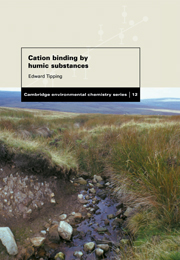Book contents
- Frontmatter
- Contents
- Preface
- 1 Introduction
- 2 Humic substances – a brief review
- 3 Environmental solution and surface chemistry
- 4 Proton dissociation from weak acids
- 5 Metal–ligand interactions
- 6 Methods for measuring cation binding by humic substances
- 7 Quantitative results with isolated humic substances
- 8 Cation binding sites in humic substances
- 9 Parameterised models of cation–humic interactions
- 10 Applications of comprehensive parameterised models
- 11 Predictive modelling
- 12 Cation–humic binding and other physico-chemical processes
- 13 Cation binding by humic substances in natural waters
- 14 Cation binding by humic substances in soils and sediments
- 15 Research needs
- References
- Index
13 - Cation binding by humic substances in natural waters
Published online by Cambridge University Press: 18 August 2009
- Frontmatter
- Contents
- Preface
- 1 Introduction
- 2 Humic substances – a brief review
- 3 Environmental solution and surface chemistry
- 4 Proton dissociation from weak acids
- 5 Metal–ligand interactions
- 6 Methods for measuring cation binding by humic substances
- 7 Quantitative results with isolated humic substances
- 8 Cation binding sites in humic substances
- 9 Parameterised models of cation–humic interactions
- 10 Applications of comprehensive parameterised models
- 11 Predictive modelling
- 12 Cation–humic binding and other physico-chemical processes
- 13 Cation binding by humic substances in natural waters
- 14 Cation binding by humic substances in soils and sediments
- 15 Research needs
- References
- Index
Summary
In this and the following chapter we shall see how knowledge about cation–humic reactions obtained in the laboratory can be used to interpret observations made on natural systems. Two approaches will be taken. Firstly, knowledge gained from studies and modelling of isolated humic substances will be used to predict, or speculate about, the circumstances in natural waters. Secondly, attempts will be made to interpret the results of measurements on natural water samples in which humic substances are suspected to exert a significant influence. For the most part, an equilibrium approach will be taken, for reasons discussed in Section 3.4.
Chemical speciation calculations
Cation–humic interactions in natural waters cannot be considered in isolation. As discussed in Chapter 3, natural waters contain many components other than humic substances, many of which combine with one another in parallel and competing reactions. Speciation calculations are therefore an essential part of understanding natural waters (and soils and sediments). Of course, a full speciation calculation, using a complicated model, is not always necessary, but the use of speciation codes such as those mentioned in Section 3.6.3 is often very helpful. WHAM (Windermere Humic Aqueous Model; Tipping, 1994) is a speciation code specifically designed to take into account interactions with humic matter, and will be used for most of the calculations in the present chapter. ECOSAT (Keizer & Van Riemsdijk, 1994), which includes the NICA model (Section 9.7), is an alternative.
- Type
- Chapter
- Information
- Cation Binding by Humic Substances , pp. 288 - 333Publisher: Cambridge University PressPrint publication year: 2002
- 1
- Cited by

